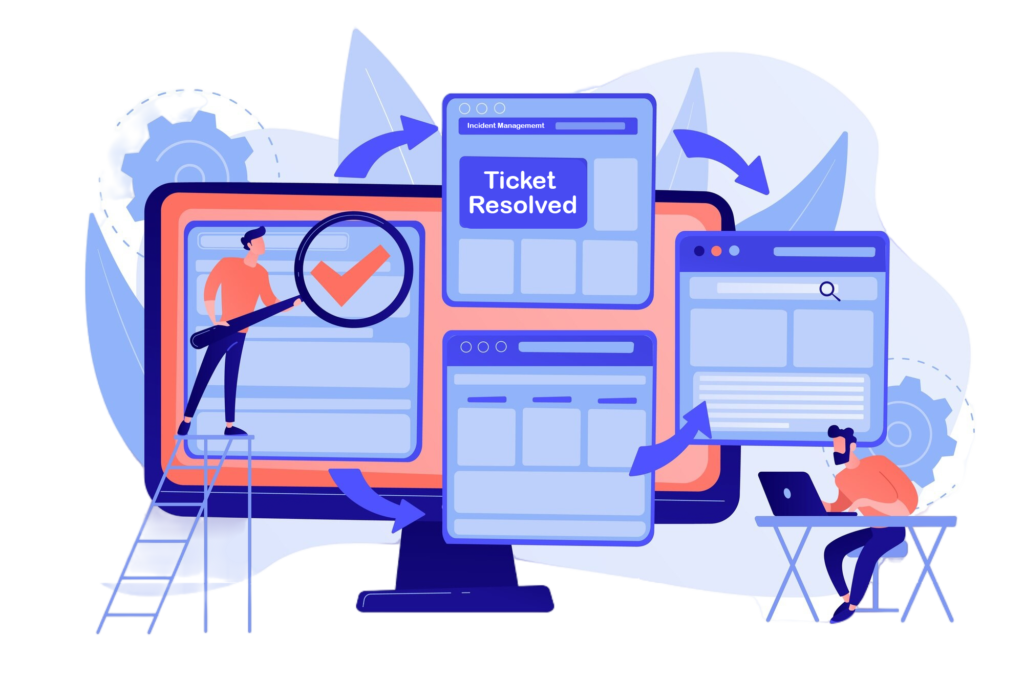

Incident Management Solution
Incident Management Solution is able to manage incident life cycle management and expose standard set of API(s) for integrating with any 3rd party alarm management system for ticketing. In addition, it supports loading its CMDB from a static inventory or dynamically discoveries from customer EMS or NMS or NE as appropriate. Moreover, it has built in service level management (SLA) function to create and manage workgroup performance. Finally, there is out of box standard dashboard and reports for analytics & continuous improvement inputs.
An efficient and effective management of Incident management solution will surely lead to reducing the mean time to repair. The solution is agnostic to the industry starting from Telecom or Communication Service Provider to IT to any enterprise grade organizations.
Key Feature
Incident Detection:
- Automated: A seamless bi-directional integration with customer centralized fault management system for creating incidents.
- Manual: There will be always an option for creating an incident by an authorized user.
Incident Logging and Prioritization:
- Automated: Based on the business rules and received request from customer centralize fault management system, incident manager can log an incident with right priority based on a two-dimensional matrix (impact and urgency).
- Manual: There will always an option in UI to define right priority based on a two-dimensional matrix (impact and urgency) while creating the incident as well as update during the incident life cycle as required.
Incident Assignment:
- Automated: Based on the business rules and received request from customer centralize fault management system, incident manager can log an incident with appropriate workgroup assigned.
- Manual: There will always an option in UI to define appropriate workgroup while creating the incident as well as update during the incident life cycle as required.
Incident CI Assignment and Management:
- CI Assignment: Based on the business rules and received request from customer centralize fault management system, incident manager attach a CI (Configuration Item) to an incident. Same can be done via Incident manager UI to attach a CI from the CMDB utilizing an advanced filtering option.
- Management: CMDB can be built and updated based on the synchronization from the customer inventory system OR our network discovery & reconciliation solution can be used to auto discover CI from the customer network. However, CI can be built from a static CSV or Excel based dump as per the pre-agreed template as an initial start.
Incident Status Update, Resolution and Closure:
- Status Update: All the status updates are logged with key information in a Work Info section.
- Resolution: This step ensures the incident resolution, root cause analysis, resolution category remarks are correctly logged for further verification and used as a future knowledge base.
- Status pushed to 3rd party Customer System: Incident status specially resolution status can be pushed to customer 3rd party centralized fault management system for actual verification of alarm clearance in case of incident resolution tagged with an alarm.
- Closure: An authorized user can mark the incident closure. Otherwise after a configurable time duration, a resolved incident shall be declared as closed in an automated manner.
Notifications:
- Media: Notification media can be E-mail, or WhatsApp or SMS.
- Status Update: Provide incident status update notifications to all the key stakeholders.
- SLA breached: Provide SLA breached notification to all key stakeholders.
Incident Trend Analysis:
- Dashboard: Incident status wise metrics and workgroup wise working-in-progress incident as well as Recurrent issues with a particular service or application.
- Report: The Incident Manager analyzes incident data to identify patterns, most faulty equipment, or CI, conducts root cause analysis, SLA breaches etc.
Service Level Agreement (SLA) Management:
- SLA Management: Ensuring incidents are resolved within agreed timelines to meet SLAs. The Incident Manager monitors incident progress, escalates issues as needed, and ensures compliance with SLAs.
- SLA Configuration: Out of the box configurable priority-based SLA shall be supported. However, customization services are available for implementing various SLA custom rules as required.
Change Management Integration:
The 365 Calander View shall provide upcoming 365 days current rate, competition rates, occupancy rate in a single view having provision to set manual price for any date after having competition rates & occupancy prediction view
Key Non-functional:
- Dashboard: Incident status wise metrics and workgroup wise working-in-progress incident as well as Recurrent issues with a particular service or application.
- Report: The Incident Manager analyzes incident data to identify patterns, most faulty equipment, or CI, conducts root cause analysis, SLA breaches etc.
Why Choose Incident Management Solution
- Monitoring systems to identify and document incidents.
- Classifying and prioritizing incidents based on urgency and impact.
- Coordinating response efforts and engaging appropriate teams to resolve incidents within Service Level Agreements (SLAs).
- Acting as the main contact for incident updates.
- Providing regular status updates to stakeholders.
- Conducting post-incident reviews to determine root causes and implementing preventive measures.
- Analyzing incident trends and recommending process improvements.
- Working closely with IT, business teams, and external vendors.
- Training and mentoring team members on incident management practices.
- Generate detailed reports on SLA compliance, including incidents resolved within SLA parameters and those that breached SLAs.
- Analyze these reports to identify areas for improvement and optimize incident management processes.
- Open eco system by integrating with customer centralize fault management system, inventory system, or change management system for efficient management.
An integrated and open incident manager solution can reduce lot of inefficiencies in incident resolution process by placing both automated and manual control over incident resolution by having correct CI and incident priority attached with.
Overall, an Incident Manager plays a crucial role in maintaining the stability and reliability of customer services, ensuring that any disruptions are handled efficiently and effectively.

